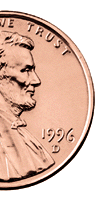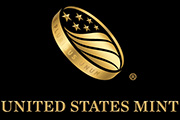Why Mint Marks?
Mint marks date from the days of ancient Greece and Rome. The practice was inaugurated in the United States by an Act of March 3, 1835, which established the first branch mints in this country. This Act provided that the Director of the Mint prescribe regulations for identifying the coins stamped at each institution, thus assuring central control of all coinage so that production from the different branches of the establishment should be exactly standard. The use of a mint mark on branch Mint coins also insured recognition of the Mint of issue when received in circulation or returned to the Mint. Thus responsibility for the coinage was established. Currently, all circulating coinage produced at the Philadelphia Mint has a "P" mint mark except for the one-cent coin, or "penny."
Philadelphia Mint Marks

Philadelphia was the only mint in operation in those earliest years, and identification of the coinage was not necessary. The practice was continued even after the branch mints were established. In 1942, however, when World War II restrictions upon the use of metal made a change in the 5-cent piece necessary, a substitute alloy composed of 35% silver, 56% copper and 9% manganese was adopted. In order to more easily distinguish between the regular copper-nickel alloy and the substitute composition, the mint mark was moved from its usual position at the right of Monticello and placed above the dome of the building on the wartime 5-cent piece. The letter "P" appeared for the first time on Philadelphia coinage. After the war, when a return to the regular alloy was made, the mint mark was restored to its former position and the letter "P" on Philadelphia coinage was discontinued.
In July of 1979, the Susan B. Anthony dollar coin was introduced, replacing the standard 1 1/2 -inch coin. Once again, the "P" mint mark was placed on Philadelphia production, this time on the dollar denomination.
Denver Mint Marks
Denver coins have always carried the letter "D" except during the date freeze mentioned later in this text. (See: The Coinage Act of 1965.)
San Francisco and West Point Mint Marks
The "S" Mint mark was used on San Francisco coins until 1955, when production there was suspended. Operations were resumed in 1965, but on a limited basis. A supplemental coinage of cents for circulation was produced from 1968 through 1974; nickels were struck in 1968, 1969 and 1970. All bore the letter "S," as did a coinage of dimes in 1975. Cents were manufactured at San Francisco for general circulation, as well as the West Point Bullion Depository, under auxiliary authority of the Congress in the early 1980's. However, in order to assure maximum circulation of this small production, no mint marks were used. Special Mint Sets were produced for collectors at San Francisco during 1965, 1966 and 1967. Due to the restrictions on coin identification in force at that time, no mint marks were used. Proof coin operations were moved from the Philadelphia Mint to San Francisco in 1968, and the letter "S" identifies that special numismatic coinage. In addition, all proof coinage produced by West Point carries a "W" mint mark.
The Coinage Act of 1965

The coinage Act of 1965 prohibited the use of mint marks for a period of five years. This, together with the date freeze, eliminated distinguishing features on our coins which could tend to cause their removal from circulation during a critical period when the Mint was striving to build up coin inventories. No mint marks appear on coins dated 1965, 1966 and 1967. Congressional authorization permitted resumption of the practice in 1968, at which time the mint marks, usually positioned on the reverse of the coins prior to 1968, were permanently relocated to the obverse side.
All master dies, including those used in the Mint's numismatics and medals programs, are manufactured in the Die Manufacturing Division of the Philadelphia Mint. Mint marks are placed in the hub at Philadelphia. This hub is the tool that produces the working dies used to stamp the coins. Working dies are then delivered to the appropriate Mint facility for coinage purposes. In addition, all working dies needed for the Denver facility are produced by the Denver Die Manufacturing Division along with some of the dies for the for the United States Mint at San Francisco. Because of its secondary position in any coin designs, it has been the custom to make the mint mark as inconspicuous as possible and still be functional.
